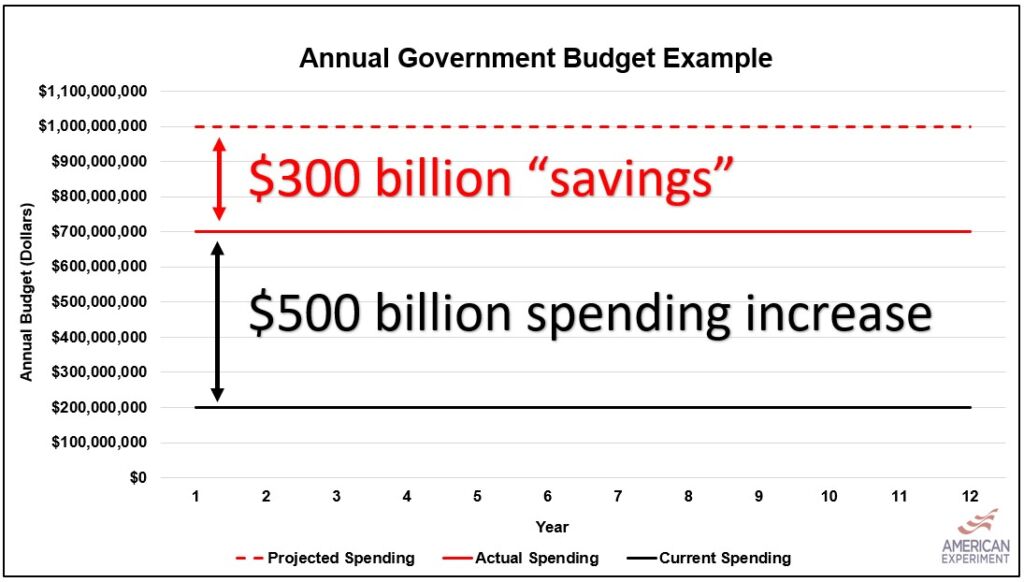Why MISO’s “net benefits” for more transmission won’t actually exist
On Monday, July 25, the board of directors for the regional electric grid to which Minnesota belongs, the Midcontinent Independent Systems Operator (MISO), voted to approve $10.2 billion in new transmission projects throughout the region, arguing the transmission lines would yield $23.2 billion to $52.2 billion present value benefits over the next 40 years.
But there’s a catch.
To help understand what the catch is and why it matters, it helps to look at an example involving a government budget.
Let’s say the federal government currently spends $200 billion per year on government programs, but some lawmakers want to increase spending to $1 trillion to pay for more government programs. Ultimately, Congress agrees to spend a total of $700 billion per year instead of $1 trillion.
Most people would probably look at this budget and agree that it increases spending by $500 billion per year, but spending advocates would argue that this bill saves $300 billion per year. This is only true if you read the fine print that says, “compared to the baseline cost estimate that assumed a total of spending $1 trillion.”

In this case, the “baseline” is not what the government currently spends but an assumed budget that increases total spending by a factor of 3.5. This same creative accounting is happening in MISO with this transmission study.
The graph below shows that MISO is modeling a “baseline” future where there will be a massive 39 gigawatt (GW) retirement of coal-fired power plants (enough to power about 4.75 Minnesota’s on the average hour) between 2020 and 2039. During this time, the MISO grid would add 37 GW of solar and 19 GW of wind.

MISO’s calculation of net benefits ranging from $23.2 billion to $52.2 billion has nothing to do with comparing the costs of running the current grid that is composed mainly of natural gas, coal, and nuclear power plants against a portfolio requiring massive investments in wind turbines, solar panels, and transmission lines.
Instead, MISO’s calculation has everything to do with assessing the cost of building massive quantities of wind turbines and solar panels with and without the new transmission lines. This all means that the transmission simply brings down the cost of adding massive quantities of wind and solar; it does not reduce costs relative to today’s baseline.
This is an important distinction because the capital cost of building these new wind turbines and solar panels alone would be $81.7 billion, using capital cost estimates from the Assumptions to the Annual Energy Outlook’s Electricity Market Module.
Wind and solar advocates were quick to lecture anyone who argued the transmission lines were expensive (and that increasing our reliance on wind and solar would increase electricity prices while reducing reliability) by saying that MISO’s analysis found it would deliver net benefits, implying that these benefits would be compared to today’s costs. But this argument is wrong, and you don’t take my word for it.
On Monday, I emailed MISO’s Long Range Transmission Planning team to confirm my theory that the net benefits were not compared to the cost of operating the existing, reliable generators.
Hello there,
My name is Isaac Orr, and I am a policy fellow specializing in energy and environmental policy at Center of the American Experiment, a think tank based in Minnesota.
I have a few questions about the modeling for the Long Range Transmission Planning analysis that was approved last week.
My main question stems from how the calculation of net benefits was performed.
My initial thought is that this analysis assumes that 53 GW of renewable capacity will be built and determines that building Tranche 1 will reduce the cost of building this 53 GW [of] wind and solar between $23.2 and $52.2 billion over 20 years. Is this correct? Also, are these wholesale power savings or retail savings?
MISO Response: The LRTP transmission portfolio was developed to enable MISO Midwest regional delivery of wholesale energy in the future where the resource fleet continues to shift toward more renewable energy and assumes the future resources needs are based on member plans and decarbonization goals as discussed in MISO Futures Report (MISO Futures Report538224.pdf). The benefits analysis did not focus on market pricing impacts, but instead determined the total net benefits provided by the Tranche 1 portfolio that includes savings from several value streams. This includes not only capital cost savings associated with the more efficient resource siting but also capture benefits related to reduced production costs, fuel savings, avoided transmission investment, etc. (see MTEP21 Addendum-LRTP Tranche 1 Portfolio Report.pdf).
Was there another model that compared [the] cost of building 53 GW of wind and solar with Tranc[h]e 1 and compares it to the cost of continuing to run the current thermal fleet?MISO Response: As a regional Transmission Provider, MISO develops transmission expansion plans to support the resource planning objectives of its members. The analysis of benefits examined the value delivered by the transmission portfolio in enabling higher penetration of renewables in a regional expansion scenario vs a more local buildout of resources and did not analyze a future that continued to maintain the current thermal fleet. Also, the LRTP Tranche 1 renewable expansion for MISO Midwest includes 56 GW of wind and solar as shown in Figure 5-3 of the MTEP21 Addendum-LRTP Tranche 1 Portfolio Report.pdf.
Any time we hear about how wind, solar, or transmission lines will “save” us money, the most important question you can ask is “compared to what?”
Almost always, the so-called savings will only exist on paper while the cost of our electric system increases and reliability falters, which is why these “savings” from transmission will never really exist in the real world.